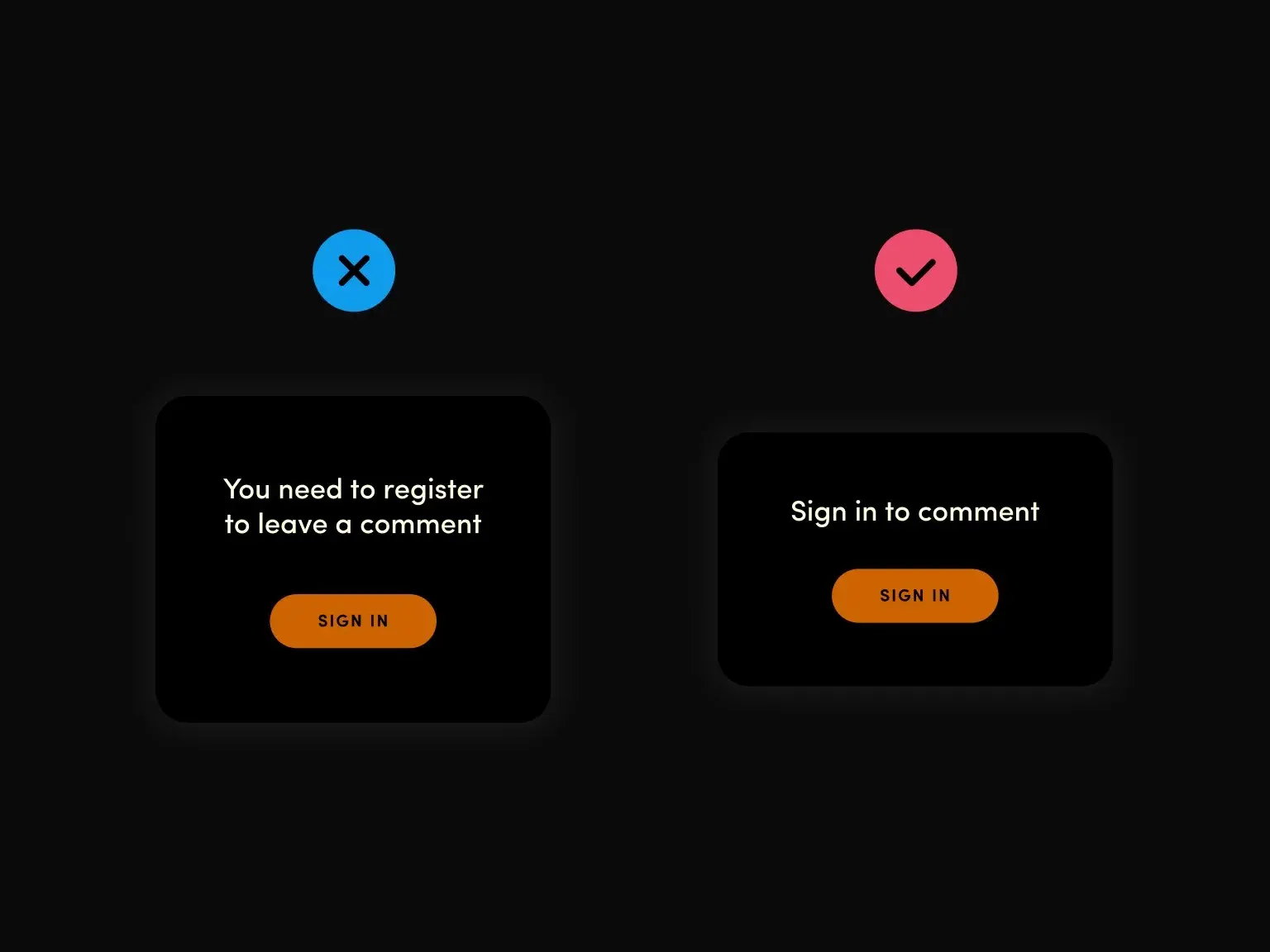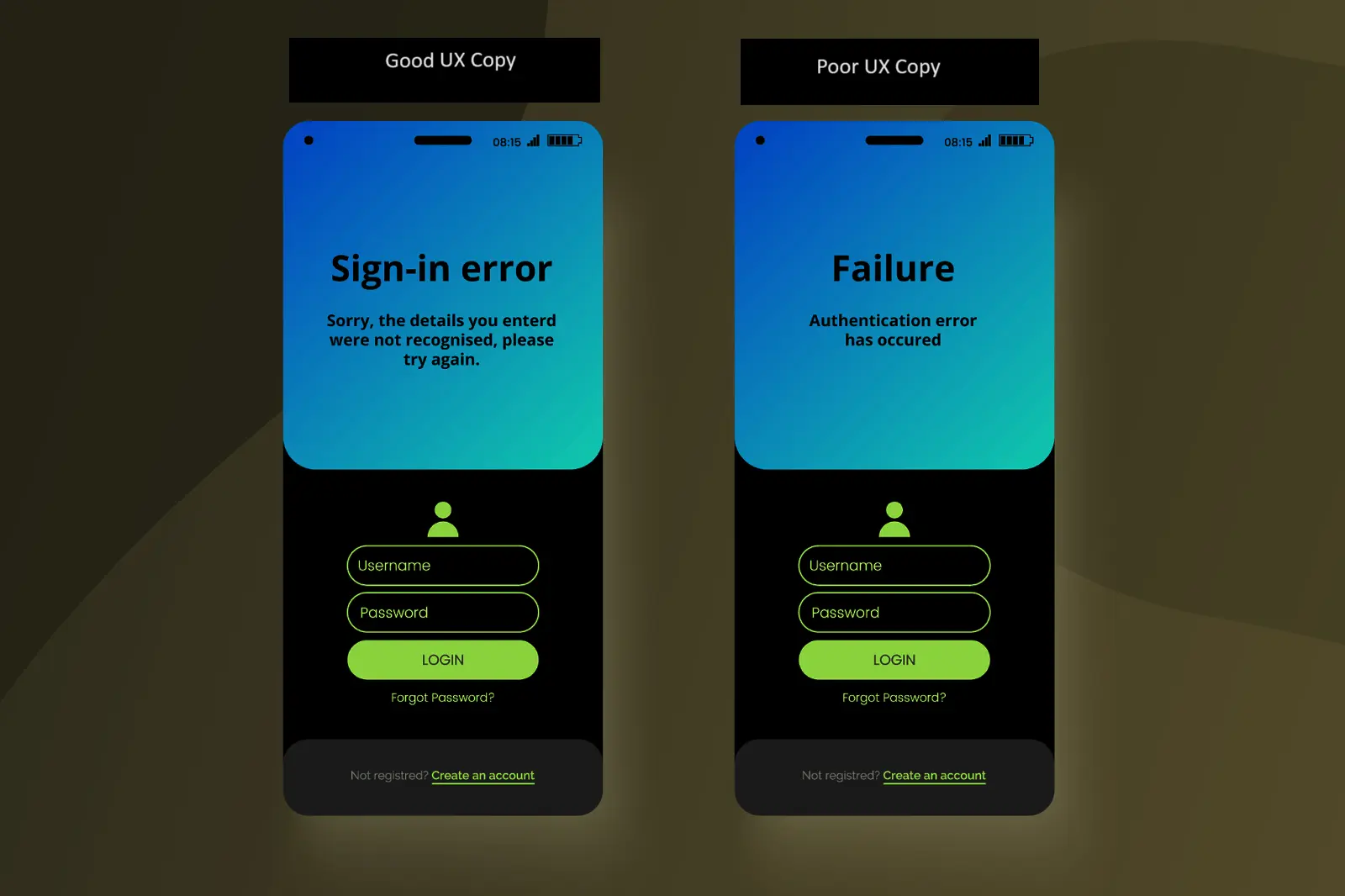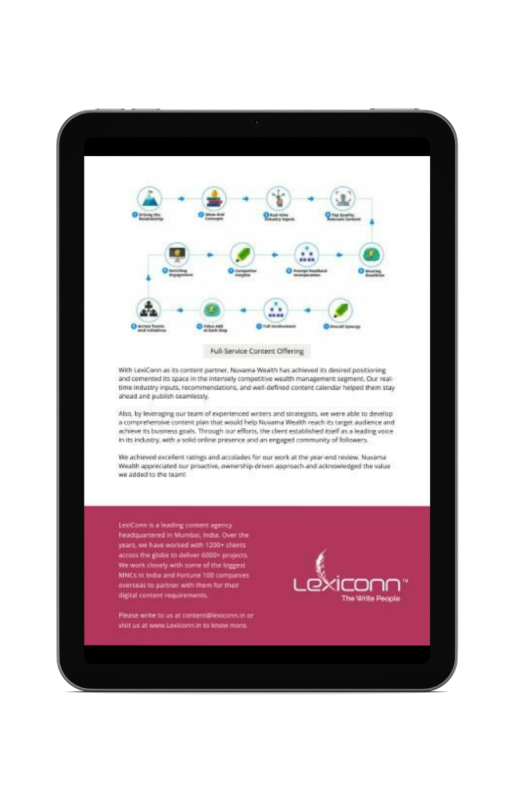
According to UXCam, 74% of visitors are likely to return to a site with good mobile UX, and 90% of smartphone users say they're more likely to continue shopping if they have a great user experience. This highlights the importance of crafting seamless, intuitive, and engaging user interfaces.
An indispensable part of user experience is UX writing which can help in stable business growth by gaining loyal and revisiting customers. This blog post delves into the profound impact of UX writing, providing insights, examples, and actionable strategies to elevate your brand's digital presence.
It's almost impossible to provide online visitors a satisfying user experience only on the basis of stunning designs. Along with user-friendly designs, UX writing is also vital.
By providing clear, consistent, and useful messaging that guides users toward their goals, it aims to improve the user experience. It ventures beyond simply writing microcopy and requires a deep understanding of users' needs and behaviors.
UX writing plays a pivotal role in this endeavor, enabling companies to create user experiences that resonate deeply with their target audience. By employing effective UX writing techniques, businesses can:
Well-crafted UX copy guides users seamlessly through interfaces, reducing abandonment and fostering continuous engagement. This translates to a more positive perception of your brand and a higher likelihood of user satisfaction.
Example of a good and bad user-guiding copy :

Consistent and on-brand UX writing reinforces your company's unique tone and voice, cultivating a cohesive brand experience across all touchpoints.
The product identity also gets a boost with the unique brand-specific UX writing, which helps the app, website, or any other digital medium stand out from the competitors.
According to Leadpages, 47.74% of businesses say user experience is vital for boosting sales. Businesses invest in attractive and engaging designs to lure buyers and customers. However, if customers are overwhelmed with the amount of data provided or find the product difficult to use, they may turn elsewhere.
Persuasive and compelling UX copy can increase conversion rates by guiding users seamlessly toward desired actions with crisp data or instructions, assisting in an easy purchase, or signing up for a service.
Inclusive and clear UX writing ensures that your digital products are accessible to diverse audiences, including those with disabilities or language barriers.
Example of a language-friendly UX app interface :

According to SMSCountry, 75% of users abandon an app within the first week if it’s difficult to use and apps with a good onboarding experience have a 50% higher retention rate.
If you are able to help users complete a specific task in a very short span through an effortless digital experience, there is a high probability of maintaining a loyal customer base year after year.
Even if new competitors try to disrupt the market with innovations and attractive offers, loyal customers will stick with your brand due to the prolonged familiarity with the native digital experience and positive customer relationships.
Clear and concise UX writing indirectly improves customer support by allowing seamless navigation without the need for customer support calls. Additionally, if an expandable (upon click) FAQ section is integrated into the UX, it assists the user with doubts. This allows your customer support team to address more vital and urgent issues.
To craft compelling and effective UX copy, adhering to a set of proven rules and industry best practices is essential. Here are a few guiding principles:
User-Centric Language: Prioritize language that resonates with your target audience, using familiar terminology and avoiding fluff or overly technical phrasing.
Scannable and Concise: Users often skim through content, so ensure your UX copy is scannable, utilizing short sentences, bulleted lists, and clear headings.
Consistent Voice and Tone: Maintain a consistent brand voice and tone throughout your UX copy, aligning with your company's values and personality.
For example, suppose a perfume brand likes to use the term “long-lasting fragrance” across all brand copies but has to alter it for a UX app interface with “lasting fragrance”.
Close Collaboration with Designers: Text and design need to complement each other to provide users with a comfortable user experience. Collaborating with UX designers in the team helps UX writers comprehend the needs of the niche audience. Designers additionally help writers visualize the live interface from the designer's perspective to make each word synchronize with every respective interface.
Contextual Relevance: UX copy should be tailored to the specific context in which it appears, providing relevant and actionable information to users.
For example, suppose in an e-commerce checkout interface, while the user is proceeding to make an online payment, a new interface with the latest product discounts appears. This will genuinely offset the reader and hamper the experience because the purchase decision has already been made and the user wants to place the order ASAP.
A/B Testing: Continuously test and refine your UX copy through A/B testing, gathering data-driven insights to optimize user engagement and conversion rates.
Some top skills of an experienced UX writer :


To illustrate the intricacies of UX writing, let's explore some ux writing examples and best practices:
Onboarding Flows: Seamless onboarding is crucial for user adoption. Effective UX writing can guide users through complex signup or setup processes, reducing friction and increasing completion rates.
Good UX Example: "Let's get you set up! First, choose a secure password to protect your account."
Poor UX Example: “App set up process begins. Decide a complex password for your account”.
Error Messages: Instead of cryptic, technical jargon, UX writing can transform error messages into helpful, actionable guidance.
Good UX Example: "Oops, something went wrong! Please check your internet connection and try again."
Poor UX Example: “ Error 407. Network switching fault. Please try later.”
Microcopy: Seemingly minor details like button labels, tooltips, and placeholders can significantly impact the user experience when crafted thoughtfully.
Good UX Example: "Add to Cart" (clear and concise)
Poor UX Example: "Click Here to Purchase" (vague and inefficient)
Instructional Copy: Step-by-step guidance can be seamlessly woven into interfaces through well-structured UX writing.
Good UX Example: "1. Upload your document. 2. Select the desired format. 3. Click 'Convert' to download your file."
Poor UX Example: “First submit your document and then select a format. Lastly, hit on the ‘Convert’ option to take your file.”
While UX writing is a specialized craft, it follows a systematic process to ensure the final product resonates with users and achieves its intended objectives. Here are the key steps to kickstart your UX writing journey:
Before you put pen to paper (or fingers to keyboard), you must have a clear understanding of your target audience. Immerse yourself in their world, their pain points, and their emotional journey. Ask questions like:
What challenges or frustrations are they facing?
How did they arrive at this particular problem?
What emotions are they experiencing?
How can you alleviate their difficulties and provide a seamless solution?
Adopting an empathetic, user-centric mindset lays the foundation for crafting copy that truly resonates.
UX writing is a collaborative endeavor, requiring input from UX designers, developers, project managers, and stakeholders across the organization. Collectively define the problem, scope, and desired outcomes. Leverage diverse perspectives to gain a holistic understanding and ensure the final solution addresses user needs effectively.
While user empathy is essential, it's crucial to validate your assumptions through rigorous research. Conduct comparative analyses, user surveys, and data-driven investigations to gather insights and solidify your understanding of the problem and its potential solutions. With coordination with the marketing team, specific surveys can be launched to get real responses from the wide customer base.
With a clear grasp of the user, problem, and potential solutions, it's time to ideate and brainstorm. Generate as many ideas and word choices as possible, without filtering or self-editing. This initial divergent thinking phase allows for exploration and creativity before refining your ideas.
From your pool of ideas, select the most promising ones and refine them into concise, clear, and user-friendly UX copy. Prioritize simplicity, using everyday language that resonates with your target audience. Avoid flowery phrasing that could hinder comprehension.
Collaborate closely with UI/UX designers to integrate your copy into the design prototypes. This step ensures your words seamlessly complement the visual elements, creating a cohesive and intuitive user experience.
Usability testing catalyzes the development of an effective user experience. Rigorously test your prototypes with real users, gathering feedback on aspects like learnability, efficiency, memorability, and error prevention.
Redevelop UX copies based on these insights, continuously improving until you achieve a high level of usability.
With user validation and stakeholder buy-in, conduct a final review of your UX copy, ensuring grammatical accuracy, consistency, and alignment with brand voice and tone. Then, release your UX masterpiece into the world, confident that it will delight users and drive engagement.
The following table highlights the core differences between content writers and UX writers, emphasizing why the latter are better suited for UX projects:
Feature
Content Writer
UX Writer
Primary Focus
Creating engaging and informative content (articles, blog posts, website copy)
Crafting clear, concise, and user-centric microcopy within digital products
Target Audience
Broad audience, often defined by marketing goals
Specific user segments within a digital product
Content Length
Longer-form content with a focus on storytelling and persuasion
Microcopy elements with tight character constraints
Collaboration
Primarily with marketing and editorial teams
Collaboration with designers, developers, and product managers
User Research and Testing
Limited involvement
Actively involved in user research, testing, and data analysis to iterate UX writing
Accessibility Focus
May not be a primary concern
Deep understanding of accessibility best practices and their implementation in UX writing
LexiConn has a dedicated team of UX writers as well as SME writers, you can learn more about LexiConn’s comprehensive content services here.
While content writing and UX writing share the foundation of strong writing skills, the specialized nature of UX writing demands a unique skillset that goes beyond general content creation. Here's why entrusting UX projects to professional UX writers is crucial:
Deep Understanding of User-Centric Design: UX writers possess a thorough understanding of user-centered design principles. They prioritize user needs, conduct user research, and translate complex information into clear, concise language that guides users through the product journey. This expertise ensures a seamless and intuitive user experience, something general content writers may not be equipped to deliver.
Focus on Microcopy and Interface Text: UX writing deals primarily with microcopy elements like labels, buttons, error messages, and instructions within the user interface. This requires meticulous attention to detail and an ability to convey meaning effectively within tight character constraints. General content writers, accustomed to longer-form content, might struggle with this level of precision and conciseness.
Collaboration with Design and Development Teams: UX writers are integral members of the product development team, collaborating closely with designers and developers. They understand the technical aspects of product development and can tailor their writing to seamlessly integrate with the overall design and functionality. This collaborative approach is often absent when relying solely on general content writers.
Expertise in Accessibility and Inclusivity: UX writers champion accessibility, ensuring their writing caters to users with diverse needs, varying readability levels and abilities. This involves using clear, neutral language and adhering to accessibility best practices. General content writers may not possess the specific knowledge and sensitivity required for this crucial aspect of UX writing.
Data-Driven Approach and Testing: Professional UX writers utilize user research data and conduct A/B testing or real-time analysis to refine their writing and measure its effectiveness. This data-driven approach ensures continuous improvement and optimizes the user experience based on real user behavior. General content writers typically lack the experience and tools necessary for this level of data analysis and iterative improvement.
Read Now : Learn How LexiConn Developed Mobile-First Microlearning Content to upskill delivery partners across the globe for Service Club, a Barcelona based HR-tech startup.
For a truly exceptional user experience (UX), UX writers must be integrated into the entire design process, not just brought in at the tail end. Imagine a designer crafting a beautiful interface, but the instructions are confusing or the buttons lack clear labels.
This disconnect disrupts the user flow. UX writers, with a focus on clear, user-centric language, can identify potential issues with the design early on. For instance, during the initial planning stages, they can suggest layout changes to ensure translated text fits comfortably.
Early involvement also allows UX writers to conduct user research and create personas. Understanding user needs and preferred language lets them craft engaging content that addresses their pain points, potentially boosting conversion rates.
Clear, user-focused content fosters a stronger connection with the target audience. Conversely, content created in isolation can feel generic and disengaging, leading to lower conversion rates. By working together from the outset, UX writers and designers can create a seamless, user-friendly experience that resonates with the target audience.
In the digital age, businesses that prioritize UX writing hold a significant competitive advantage. By crafting clear, concise, and user-centric copy, companies can enhance user engagement, strengthen brand identity, and ultimately drive conversions and customer loyalty.
Words have the power to make any software human-centered. Therefore, they need just as much consideration as the program coding and product branding. Embrace the power of UX writing, and witness your business soar to new heights of success amidst the competitive developments in your industry.
LexiConn has a dedicated UX writing team that works with clients across multiple industries, offering fresh writing perspectives to enhance user experience and improve customer engagement.
We also offer a free 30-minute content consultation session to help you with your content strategy.
You can also drop us a line at content@lexiconn.in for any requirements or questions. We’ll be glad to connect and discuss how we can collaborate to unlock growth opportunities for your organization!


I have read and accept the Privacy Policy
Read More